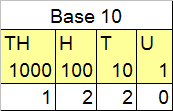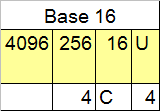Operations
An operation is a rule , or set of rules, for processing one or more object.
A binary operation is one which combines two objects to make a third.
Addition, Subtraction, Multiplication and Division are all examples.
An operator is the symbol used to show which operation is to be done.
+ Addition
Augend : the number to which another is added.
Addend : the numbers to be added together.
Summand : a quantity to be added to another.
Sum : the result of addition of numbers
augend + addend = sum
- Subtraction
Minuend : the amount from which something is to be subtracted..
Subtrahend : the number to be taken away
Difference: the result of subtraction of numbers.
minuend − subtrahend = difference
x Multiplication
Multiplicand : the amount which is to be multiplied.
Multiplier : the amount by which to multiply.
Product : the result of a multiplication.
multiplicand × multiplier = product
÷ or / Division
Dividend : the amount which is to be divided
Divisor : the amount by which to divide.
Quotient : the whole number result of dividing numbers
Remainder :
what is left over, often expressed as a fraction of the divisor.
dividend ÷ divisor = quotient + (remainder ÷divisor )
A commutative operation is one in which the order does not matter.
The numbers can move around.

Addition is commutative since 3 + 2 = 2 + 3
Subtraction is not, since 3-2 ≠ 2-3
Multiplication is commutative since 3 x 2 = 2 x 3
Division is not, since 3÷2 ≠ 2÷3
7 +( 5 +2 ) = 7 + ( 2+5) = 14

A binary operation is associative if grouping makes no difference.
The numbers can freely associate with each other!
Addition is associative since 3 + 2 +5 = 3 + ( 2 + 5)
4 + (5 +6) = (4 + 5) + 6
Subtraction is not, since 5-3-2 ≠ 5-( 3 - 2)
Multiplication is associative since 3 x 2 x 5 = 2 x (3 x 5)
Division is not, since 12÷ 3÷2 ≠12÷(3÷2)
The distributive property of multiplication over addition or subtraction.
Multiplying a sum by a number gives the same result as multiplying each addend by the number and adding the result.

In general,
![]()
Usually, the multiplication sign is left out.
![]()
The identity for a binary operation on a set is an object in the set which is combined with an operator on any second object to produce a result equal to that second object.

e.g. a + 0 = a = 0 + a
so 0 is the identity for addition.
Addition

Multiplication

Subtraction

Division

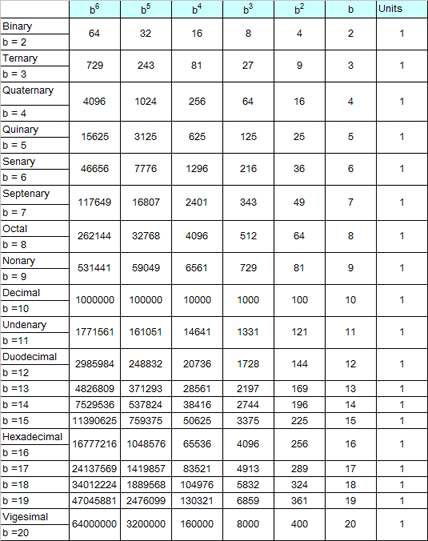

Examples
1510 = 11112= 305
(This is read as 15 in base ten is equal to 1111 in base 2 or thirty in base 5)
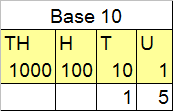
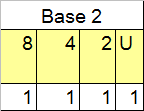
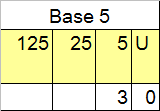
The subscript shows the base.
They can also be written 15dec = 1111bin
where dec stands for decimal and bin stands for binary
In Hexadecimal, the letters A to F are used to represent
the numbers from 10 to 15
A =10 B = 11 C = 12 D = 13 E=14 F=15
So 1220 dec = 4C4hex
